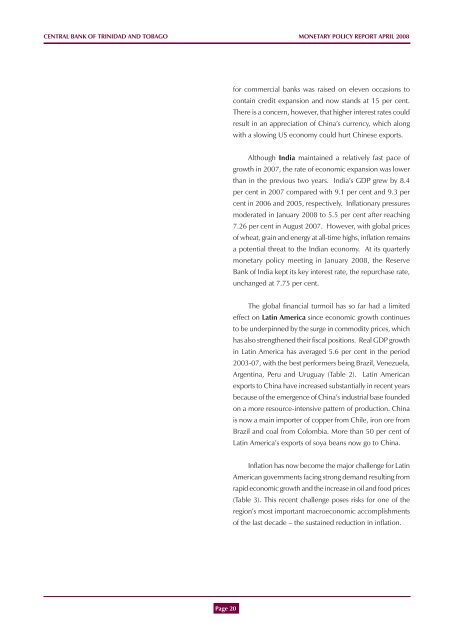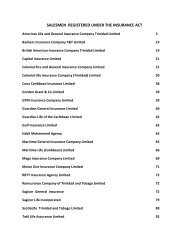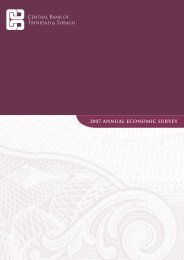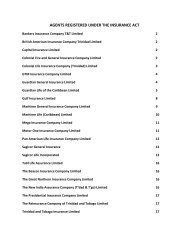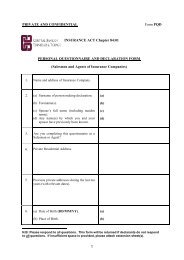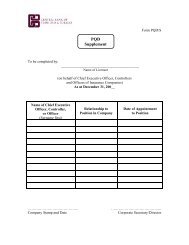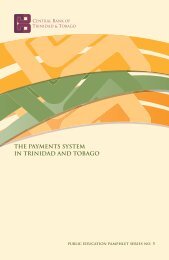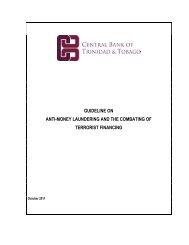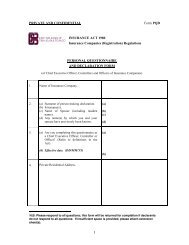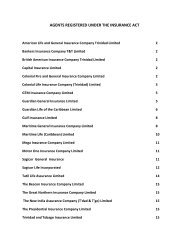April 2008 Report - Central Bank of Trinidad and Tobago
April 2008 Report - Central Bank of Trinidad and Tobago
April 2008 Report - Central Bank of Trinidad and Tobago
Create successful ePaper yourself
Turn your PDF publications into a flip-book with our unique Google optimized e-Paper software.
CENTRAL BANK OF TRINIDAD AND TOBAGO MONETARY POLICY REPORT APRIL <strong>2008</strong><br />
for commercial banks was raised on eleven occasions to<br />
contain credit expansion <strong>and</strong> now st<strong>and</strong>s at 15 per cent.<br />
There is a concern, however, that higher interest rates could<br />
result in an appreciation <strong>of</strong> China’s currency, which along<br />
with a slowing US economy could hurt Chinese exports.<br />
Although India maintained a relatively fast pace <strong>of</strong><br />
growth in 2007, the rate <strong>of</strong> economic expansion was lower<br />
than in the previous two years. India’s GDP grew by 8.4<br />
per cent in 2007 compared with 9.1 per cent <strong>and</strong> 9.3 per<br />
cent in 2006 <strong>and</strong> 2005, respectively. Inflationary pressures<br />
moderated in January <strong>2008</strong> to 5.5 per cent after reaching<br />
7.26 per cent in August 2007. However, with global prices<br />
<strong>of</strong> wheat, grain <strong>and</strong> energy at all-time highs, inflation remains<br />
a potential threat to the Indian economy. At its quarterly<br />
monetary policy meeting in January <strong>2008</strong>, the Reserve<br />
<strong>Bank</strong> <strong>of</strong> India kept its key interest rate, the repurchase rate,<br />
unchanged at 7.75 per cent.<br />
The global financial turmoil has so far had a limited<br />
effect on Latin America since economic growth continues<br />
to be underpinned by the surge in commodity prices, which<br />
has also strengthened their fiscal positions. Real GDP growth<br />
in Latin America has averaged 5.6 per cent in the period<br />
2003-07, with the best performers being Brazil, Venezuela,<br />
Argentina, Peru <strong>and</strong> Uruguay (Table 2). Latin American<br />
exports to China have increased substantially in recent years<br />
because <strong>of</strong> the emergence <strong>of</strong> China’s industrial base founded<br />
on a more resource-intensive pattern <strong>of</strong> production. China<br />
is now a main importer <strong>of</strong> copper from Chile, iron ore from<br />
Brazil <strong>and</strong> coal from Colombia. More than 50 per cent <strong>of</strong><br />
Latin America’s exports <strong>of</strong> soya beans now go to China.<br />
Inflation has now become the major challenge for Latin<br />
American governments facing strong dem<strong>and</strong> resulting from<br />
rapid economic growth <strong>and</strong> the increase in oil <strong>and</strong> food prices<br />
(Table 3). This recent challenge poses risks for one <strong>of</strong> the<br />
region’s most important macroeconomic accomplishments<br />
<strong>of</strong> the last decade – the sustained reduction in inflation.<br />
Page 20


